Pattern Recognition: Latest Techniques and Applications
Table of Contents
- TL;DR
- Understanding Pattern Recognition: Process and Latest Trends Overview
- Recent Advances in Pattern Recognition: Exploring New Algorithms
- Types of Pattern Recognition
- Techniques for Enhancing Pattern Recognition
- Applications of Pattern Recognition
- Addressing Challenges in Pattern Recognition
- How to Train Your Model to Recognize Patterns with Label Your Data
- About Label Your Data
- FAQ

TL;DR
- Use pattern recognition techniques to automate pattern identification and improve data-driven decision-making.
- Leverage advanced methods like CNNs for image analysis and Transformers for processing text efficiently.
- Apply pattern recognition in key areas like computer vision, NLP, healthcare, finance, and marketing to enhance AI solutions.
- Focus on improving data quality, preventing overfitting, and increasing model interpretability for reliable results.
- Optimize your models with techniques like feature extraction, ensemble learning, and cross-validation.
Understanding Pattern Recognition: Process and Latest Trends Overview
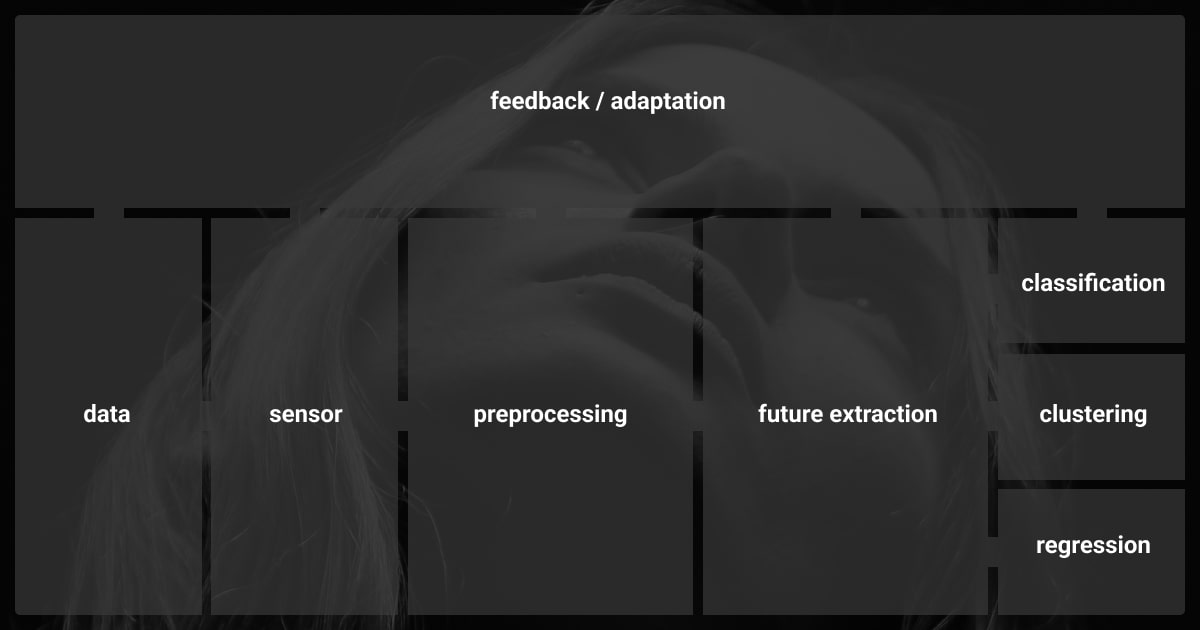
Most of the daily tasks we automate rely on good old pattern recognition in machine learning. But today, it’s more than just identifying patterns in data.
But what is pattern recognition? At its core, it is the automated identification of patterns, regularities, and trends in data using statistical techniques and ML algorithms. Pattern recognition enables machines to analyze complex datasets and make informed decisions.
At its core, pattern recognition systems automate the process of extracting valuable insights from unstructured data, such as images, text, or video. The ability to recognize patterns is what allows AI to detect faces in photographs, understand spoken words, and predict trends in stock prices.
Yet, today’s pattern recognition techniques are different from earlier ones. They process a large amount of complex data and use advanced algorithms.
Recent Advances in Pattern Recognition: Exploring New Algorithms
While traditional pattern recognition methods like k-nearest neighbors (k-NN), support vector machines (SVM), and decision trees remain relevant, deep learning techniques have revolutionized the field.
For those working on ML projects, staying up to date with the latest trends in this field to harness the full potential of AI. Here’s a deeper look at the newest pattern recognition algorithms and how you can apply them in your projects today:
Convolutional Neural Networks (CNNs)
Convolutional neural networks are essential for computer vision. They excel at identifying patterns in images, such as faces, objects, or handwritten digits. By using convolutional layers to detect local patterns and pooling layers to reduce dimensionality, CNNs have become the go-to model for tasks like AI image recognition, object detection, and autonomous driving.
Transformers in NLP
In natural language processing techniques, the transformer architecture, especially models like BERT and GPT, has taken pattern recognition to new heights. These models recognize patterns in text sequences, making them suitable for tasks such as text classification, sentiment analysis, and language translation. The ability to process entire sequences at once rather than step-by-step gives transformers a significant edge in detecting patterns in context.
Self-Supervised Learning
Self-supervised learning is one of the emerging pattern recognition approaches where models learn representations from unlabeled data by predicting parts of the input data. This pattern identification technique allows models to perform well on new tasks with minimal supervision, which is particularly useful when labeled data is scarce.
Ensemble Methods: Bagging and Boosting
Ensemble learning improves the accuracy of pattern recognition systems by combining the strengths of multiple models. Bagging (Bootstrap Aggregating) and Boosting are two popular ensemble methods. Bagging reduces variance by training multiple models on different subsets of the data, while Boosting sequentially trains models to correct the errors of the previous ones, resulting in better generalization.
Transfer Learning
In many cases, creating a pattern recognition system from scratch is impractical due to time and resource constraints. Transfer learning addresses this by using pre-trained models as a starting point, which can then be fine-tuned for specific applications of pattern recognition. Transfer learning is particularly effective for tasks with limited labeled data, as it leverages knowledge from large, general datasets to improve performance.
Preventing data drift by integrating real-time corrections into applications is a promising approach. This ensures that models remain dynamic and adaptive to changes without requiring extensive retraining.
Types of Pattern Recognition
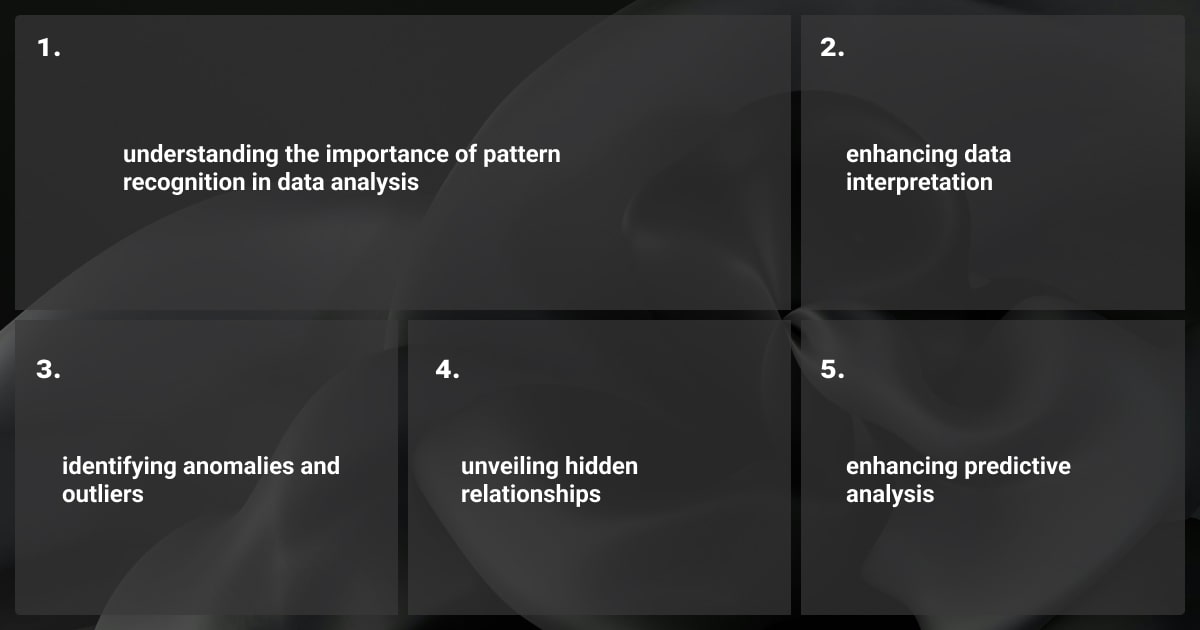
There are two main types of pattern recognition: supervised and unsupervised learning. Each has distinct applications and requirements:
Supervised Pattern Recognition
In supervised learning, models are trained using labeled datasets, making them ideal for classification in pattern recognition tasks. This approach is used in applications such as facial recognition and medical diagnostics, which aim to categorize input data into predefined classes.
Unsupervised Pattern Recognition
Unsupervised learning deals with unlabeled data. Models are trained to find hidden patterns or groupings within the data, known as clustering. For instance, in marketing, unsupervised pattern recognition is used to segment customers based on buying behaviors without predefined labels.
Self-Supervised Pattern Recognition
A third, less common but important category, is semi-supervised learning. It blends the two pattern recognition approaches. This method is useful when there is a small amount of labeled data and a larger pool of unlabeled data.
Techniques for Enhancing Pattern Recognition
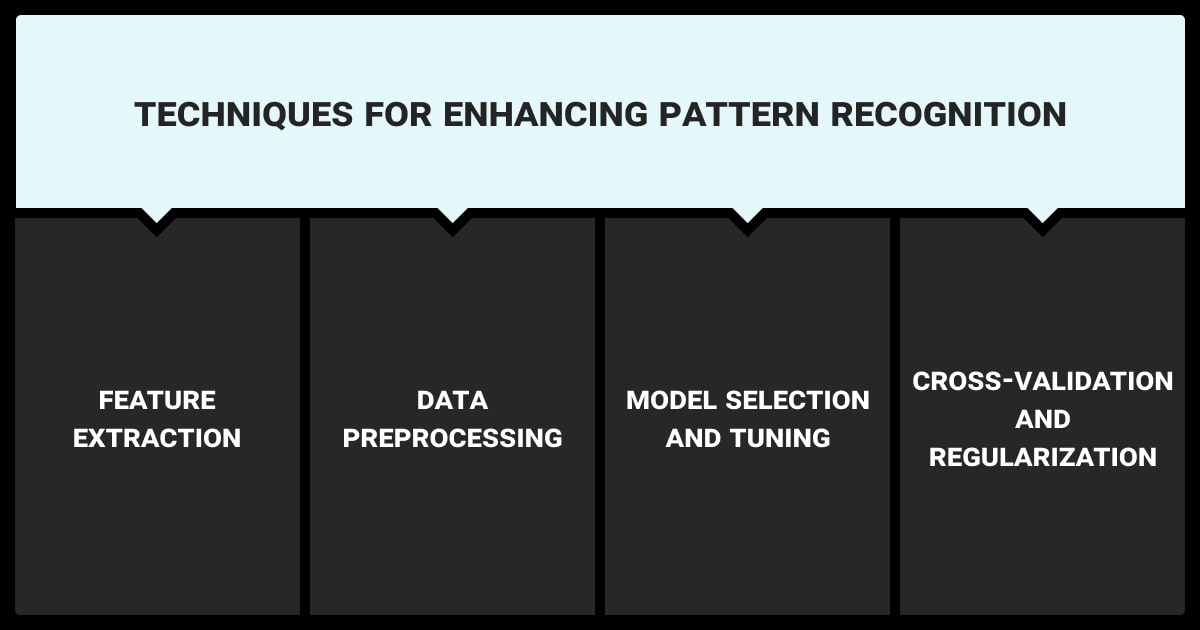
Building a robust pattern recognition system involves several vital techniques:
1. Feature Extraction
Effective pattern recognition AI starts with selecting the right features. Feature extraction involves transforming raw data into a format that highlights the most relevant aspects of model training. This can be seen in one of the pattern recognition examples, image recognition. Here, feature extraction may focus on edges, textures, and shapes, vital for identifying objects.
2. Data Preprocessing
Clean and normalized data is essential for achieving high accuracy. Preprocessing steps such as data augmentation, normalization, and noise reduction improve the quality of the input, leading to more effective pattern recognition.
Focusing on data quality, preventing overfitting, ensuring scalability, and maintaining regular model updates can help you successfully implement pattern recognition in large-scale ML applications.
3. Model Selection and Tuning
Choosing the right pattern recognition algorithm is critical. Depending on the data type and application of pattern recognition, different models may perform better. For example, CNNs are ideal for image data, while recurrent neural networks (RNNs) or transformers work better for time-series and sequential data.
4. Cross-Validation and Regularization
To avoid issues like overfitting, techniques such as cross-validation and regularization are employed. Cross-validation helps ensure that the model generalizes well to new data, while regularization adds penalties to model complexity, reducing the likelihood of overfitting.
Applications of Pattern Recognition
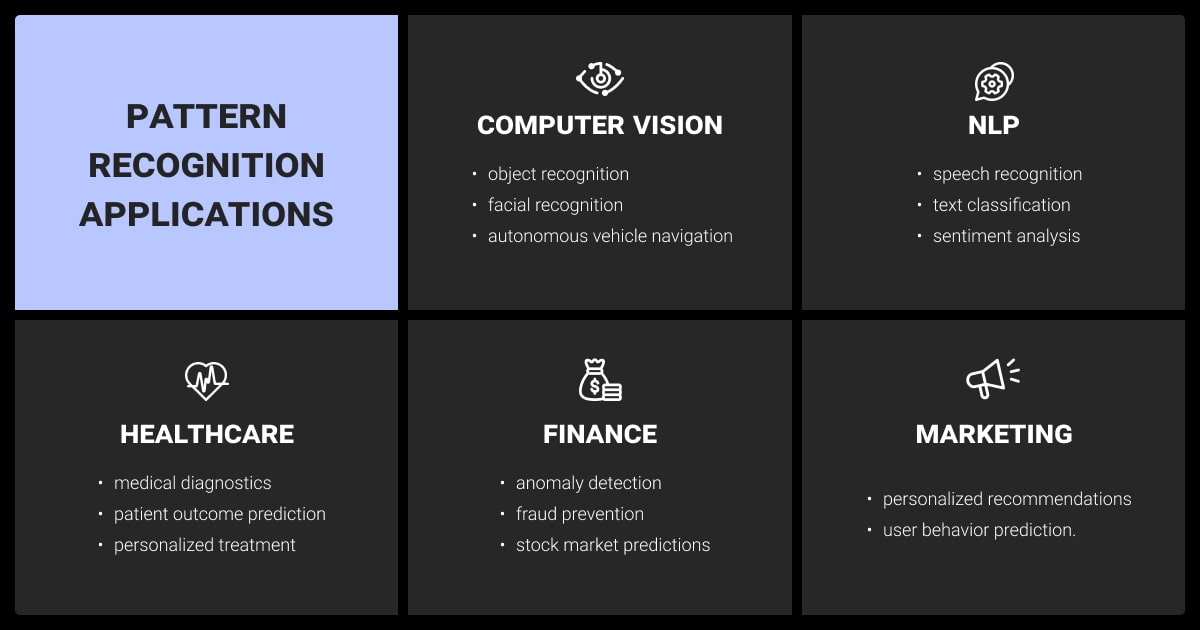
In AI, pattern recognition algorithms are deployed in systems that can handle both structured and unstructured data. These systems perform tasks like classification in pattern recognition, object detection, and anomaly detection. They are trained to recognize relationships within the data, making them invaluable across a range of applications.
The applications of pattern recognition are vast, cutting across multiple industries and disciplines. Here are some of the most prominent use cases you should know about:
Computer Vision
In computer vision, pattern detection is used for object recognition, facial recognition, and autonomous vehicle navigation. Self-driving cars rely heavily on pattern recognition algorithms to interpret their environment, recognize pedestrians, and navigate through traffic.
Enhance your AI vision models with high-quality computer vision services.
Natural Language Processing
In NLP, pattern recognition techniques enable tasks like speech recognition, text classification, and sentiment analysis. Voice assistants like Siri and Alexa use AI pattern recognition to understand and respond to user queries.
Unlock the full potential of your text data with precise NLP services.
Healthcare
Medical diagnostics benefit immensely from pattern recognition applications. For instance, AI systems in healthcare can analyze medical images to detect tumors, predict patient outcomes, and assist in personalized treatment planning.
Improve your diagnostic model’s accuracy with precise data annotation services for healthcare!
Finance
In the financial sector, pattern recognition systems are used for anomaly detection, fraud prevention, and stock market predictions. AI-powered algorithms can analyze vast amounts of financial datasets to identify trends and make predictions about future market behavior.
Boost fraud detection and market predictions with expert data annotation services in finance!
Marketing and Personalization
Companies use pattern recognition to analyze consumer data and create personalized recommendations. From streaming platforms to e-commerce websites, AI systems learn user preferences and predict behavior to enhance customer experience.
Addressing Challenges in Pattern Recognition
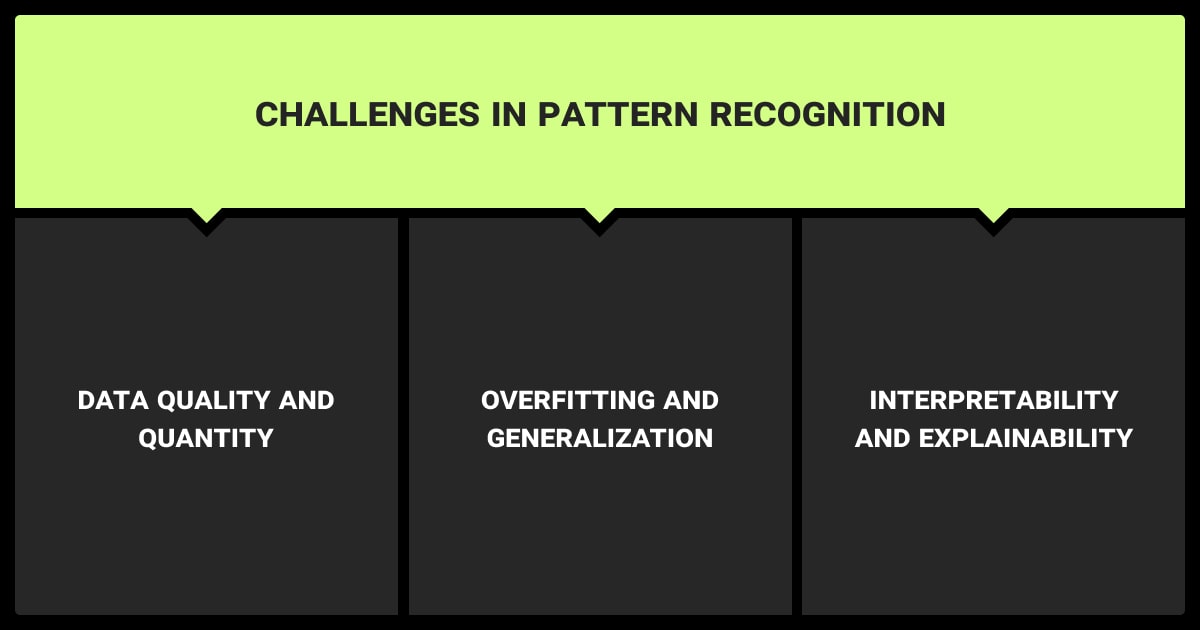
Despite its widespread use, pattern recognition still presents significant challenges. Here are the issues that we believe are the most pressing for ML teams:
Data Quality and Quantity
High-quality, labeled data is essential for building reliable pattern recognition models. However, noisy or incomplete data can lead to poor model performance, and this is closely linked to false pattern recognition—when models incorrectly identify patterns that don't exist due to biases or noise in the data.
Mitigation: Data augmentation, improving data collection processes, and using semi-supervised learning.
Overfitting and Generalization
Overfitting occurs when a model performs well on training data but fails to generalize to unseen data. This can exacerbate false pattern recognition, as the model may learn to identify patterns specific to the training data but not applicable to new data.
Mitigation: Cross-validation, regularization techniques, and simplifying the model architecture.
Overfitting is one major issue in large-scale datasets, where irrelevant features or high-dimensional data can lead to spurious correlations. To mitigate this, techniques like regularization, dropout, and cross-validation should be applied, along with simplifying the model architecture to generalize better across unseen data.
Interpretability and Explainability
Deep learning models, often used in pattern recognition AI can function as "black boxes," making it difficult to understand how decisions are made. This lack of transparency can make it hard to identify spurious correlations or misleading patterns when a model identifies them.
Mitigation: Explainable AI (XAI) techniques, like SHAP or LIME, can help detect and prevent false pattern recognition while improving trust in model outcomes.
How to Train Your Model to Recognize Patterns with Label Your Data
As we dive into the technical aspects of pattern recognition, you cannot go without annotated data. ML models rely on labeled data to understand and extract meaningful patterns from raw input.
By annotating data for ML projects for over 4 years, we provide the ground truth necessary for supervised learning. Here, your model learns to map input data (images, text, or audio) to output labels.
In pattern recognition, the model identifies features or structures in the input data, such as edges in images, word embeddings in text, or frequency components in audio signals. These features are used to detect patterns across different samples. However, if the labels are inaccurate or inconsistent, the model may learn the wrong patterns, leading to overfitting, poor generalization, or false pattern recognition.
Maximize the accuracy of your pattern recognition models with high-quality annotated datasets from our experts. Run a free pilot today!
About Label Your Data
If you choose to delegate data annotation, run a free data pilot with Label Your Data. Our outsourcing strategy has helped many companies scale their ML projects. Here’s why:
Check our performance based on a free trial
Pay per labeled object or per annotation hour
Working with every annotation tool, even your custom tools
Work with a data-certified vendor: PCI DSS Level 1, ISO:2700, GDPR, CCPA
FAQ
What is pattern recognition in NLP?
In Natural Language Processing (NLP), pattern recognition identifies linguistic patterns in text, such as word relationships, syntax, or sentiment. It’s used in tasks like text classification, language modeling, and sentiment analysis.
How do you train AI to recognize patterns?
AI models are trained to recognize patterns by feeding them with large amounts of labeled data, which they process using machine learning algorithms. During training, the AI learns to identify and generalize patterns by adjusting its internal parameters to minimize error. Techniques like supervised or unsupervised learning are commonly used, along with advanced models like neural networks and deep learning.
Is pattern recognition deep learning?
Pattern recognition is not exclusively deep learning, but deep learning is one of the most effective approaches for it. Deep learning, especially using neural networks like Convolutional Neural Networks (CNNs), excels at recognizing complex patterns in large datasets, such as images, text, or speech. Traditional pattern recognition can also involve other machine learning algorithms like decision trees or support vector machines.
Written by
Karyna is the CEO of Label Your Data, a company specializing in data labeling solutions for machine learning projects. With a strong background in machine learning, she frequently collaborates with editors to share her expertise through articles, whitepapers, and presentations.





